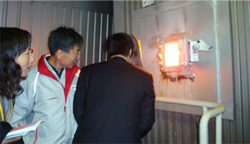Home > Highlighting JAPAN > Highlighting Japan FEBRUARY 2011 > Feeling the Co-benefits
Highlighting JAPAN
COVER STORY: Sustainable Cities
Feeling the Co-benefits
Japan is promoting the co-benefits approach to simultaneously deliver greenhouse gas reductions and environmental pollution prevention in developing countries. The Japan Journal's Osamu Sawaji reports.

Visitors from China look inside a boiler at the Electric Power Development Co.'s Isogo Thermal Power Station in Yokohama, Kanagawa Prefecture, as part of ongoing Japan-China co-benefit cooperation. This coal-burning station is equipped with some of the world's leading technologies to combat atmospheric pollution.
Credit: COURTESY OF THE MINISTRY OF THE ENVIRONMENT
Hiroaki Takiguchi, director of the International Cooperation Office at the Ministry of the Environment, comments, "The impact of climate change increases even while lengthy international negotiations continue. That is why we must reduce GHG in developing countries as much as possible from now on. In this context, the co-benefits approach, which implements GHG reduction and measures to counter environmental pollution while adapting to the development needs of the developing countries, has been attracting attention worldwide in recent years."
As specific examples of the co-benefits approach, one might list efficiency improvements to thermal power plants, methane recovery and power generation from industrial effluent, and improvement in efficiency of public transportation networks.
Japan has already implemented advanced measures in these fields. In the period of rapid growth from the latter half of the 1950s, Japan experienced serious environmental pollution, but since the 1960s, the public and private sectors have cooperated and taken measures to combat pollution. In addition, as a result of the huge impact of the two oil shocks in the 1970s when the cost of living rose rapidly, the government has promoted the formulation of a legal framework for energy efficiency, and the business sector has developed energy足efficient technologies.
As a result of these initiatives, Japan has made dramatic improvements in pollution and implemented effective energy consumption with the consumption of energy in the industrial sector remaining flat over the thirty-year period from the early 1970s to the early 2000s when GDP approximately doubled.
Takiguchi comments, "In terms of results, Japan's efforts in reducing pollutants and achieving energy efficiency were consistent with its economic growth. Utilizing the experience and technologies accumulated in the past to provide support for technologies, systems and human resources training in developing countries is a role for Japan."
Bilateral cooperation agreements aimed at promoting the co-benefits approach both with China and with Indonesia. Japan is carrying out human resources training and joint research on the effects of co-benefits.
Co-benefits, Changing Lives
The Ministry of the Environment also started a co-benefits CDM (Clean Development Mechanism) feasibility study in 2007, subsidizing half of the initial investment to private enterprises selected for the model project. One of the projects is underway in Thailand. It is a project to collect biogas from wastewater in an ethanol factory and to use the gas for the boiler at the factory while improving the water quality of the waste liquid. In terms of CO2 conversion, this project is expected to reduce GHG by 15,000 tons CO2 equivalent annually.
Kazuhito Yamada, director of Pacific Consultants-Institute for Global Environment Research, comments, "The co-benefits approach not only prevents atmospheric pollution and water quality contamination, but it also enables contributions to sustainable development, which is the principal CDM objective."
Speaking of CDM projects, large-scale projects such as renewable energy or destruction of chemical substances with high global warming potential such as HFC23 at factories have been the mainstream. However, Yamada believes that in the future it will be necessary to conduct activities that are closely connected to the everyday lives of people and register them as CDM projects. Yamada cites the example of Nippon Poly-Glu, which is involved in the supply of safe drinking water."
"In order to supply safe water, electricity is required for normal water services, purification and other processes. If it is possible to supply safe drinking water without using electricity, it is the equivalent of reducing CO2 emissions by the quantity of unused electricity. There are many examples of co-benefits that people may not be aware of."
In terms of co-benefits approaches, Yamada is currently involved in a project to compost sewage sludge using the YM bacteria at a sewage treatment plant scheduled in Nanjing City in China. The YM bacterium is a microbe that was discovered by Masaichi Yamamoto of Sanyu Co. in Japan. If you add YM bacteria to organic matter such as sewage sludge or food scraps, and send air through the mixture, the organic matter ferments and decomposes at high temperatures over 100 degrees. Then, after forty-five days it becomes good quality compost that does not emit any foul smells. It is possible to prevent the atmospheric release of the methane gas that forms in the process of decomposition when untreated sludge is buried in landfills.
Yamada comments, "Japanese and Chinese corporations are cooperating, aiming to develop this project as CDM projects. In the future, I would like to increase the number of CDM projects that contribute directly to improving people's lives."
© 2009 Cabinet Office, Government of Japan






